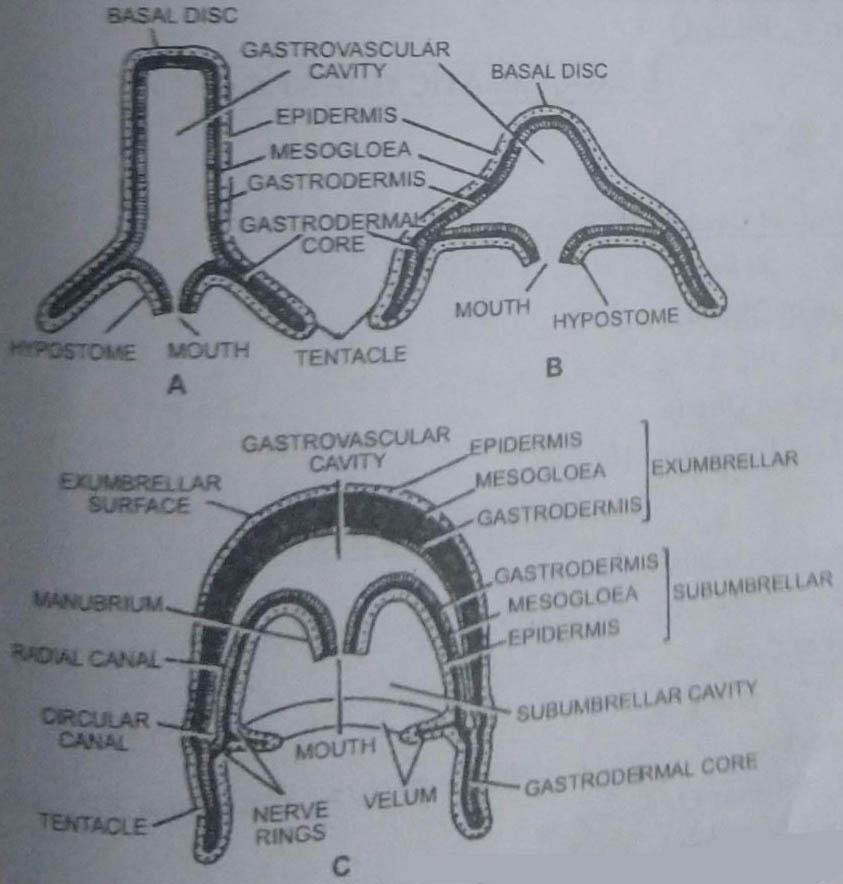Q.5. Give a detailed account of the structure and development of the medusa of Obelia and discuss its homologies with polyp.
Or
“Although the polyp and medusa of obelia are anatomically and physiologically different but are structurally homologous” Justify such statement.
Ans.5. The polyp and medusa are two different types of zooids found in the colony of Obelia. These exhibit great differences in form and structure, which can be explained due to different functions brought about by them. The polyp is the nutritive zooid, while the medusa is reproductive zooid. Their comparison can be made under the following steps:
Homologies or similarities Between Polyp and Medusa
Though the polyp and medusa exhibit marked differences, still these are strictly homologous. These are formed on the same fundamental pattern. The similarities can be enumerated as follows:
1. The body is radially symmetrical.
2. The body wall is diploblastic.
3. The mouth and hypostome of polyp are homologous to the mouth and manubrium of medusa. The anus is absent in both.
4. The stomach, radial canals, and the circular canals of medusa are homologous to the gastrovascular cavity of polyp.
5. The convex outer surface of the umbrella of medusa corresponds to the base of hydranth.
6. Both are carnivorous.
Advancement of Medusa over Polyp
The free-swimming habit of medusa is mainly responsible for its complicity differentiation of structures lying along certain radii. Thus the advancements shown by medusa over polyp are:
1. The epidermis of medusa resembles the epithelium of higher metazoa in being a thin, protective, and sensitive layer.
2. The great power of contractility provided by numerous muscle-cells present in sub-umbrella and velum.
3. The enormous development of mesogloea provides lightness and buoyancy to the free-floating body.
4. The gastrovascular cavity is reduced to a system of canals.
5. Presence of marginal sense organs at the bases of ad-radial canals. This is a great advantage to the free-swimming medusa.
6. The presence of gonads in the freely swimming medusae provides greater chances of dispersal.
7. Medusa is not sessile like polyp and is able to swim freely by its muscular action.
Derivation of Medusa from Polyp
Homology and similarity in the structure of polyp and medusa can be explained as the fact that one can be easily derived from the other.

On pulling out the tentacles, a disc-like form results. On compressing the basal region of the disc, a cup-shaped or umbrella-shaped form like a medusa occurs. This cup-like form contains an outer, convex exumbrellar surface and an inner, concave subumbrella surface. The manubrium hangs in the centre and tentacles hang from the periphery of the cup, as in medusa.
The actual medusa-like condition can be produced by bringing the upper and lower layers closer except in the region of the gastrovascular cavity, four radial canals and a marginal circular canal.
Similarly, by pulling out and elongating the exumbrellar surface of medusa, a polyp-like structure is formed.
BSc 1st Year Lower Non-chordates Obelia Sample Model Practice Question Answer Papers
BSc 1st Year Sample Model Practice Mock Test Question Answer Papers